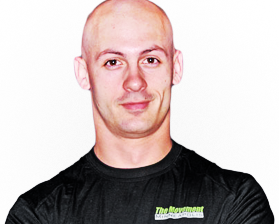
The other night I was working with a client in the gym and I was reminded of something very important that I don’t know that I have specifically written about before. First a little bit of background so this makes more sense:
Biofeedback testing is by far the most useful “tool” I’ve ever found for training. In sort of economic terms it allows you to get more and better results at a lower cost and lower risk. Over the long term, like compounding interest, it adds up to a lot more progress because you’re not giving up training days to recovering from injuries.
Even knowing this, there are times when you might not actually need to use the testing as much. When you’re totally healthy, everything is working well, and you have a really wide range of function and the ability to push those to the limit you might not need to test often, or at all. You can coast on your intuition that has been honed by time spent actually testing. If you’re really healthy, you can get away with not testing at all, at least for a while.
But, the scenario is exactly reversed when you’re not totally healthy – especially when you’re dealing with a chronic pain situation. To be perfectly clear here, I’m not talking about sudden acute pains or any kind of pain that hasn’t been cleared by a competent medical professional. I’ve heard enough horror stories of someone just working around pain that didn’t get better only to find out that it was something incredibly serious that needed to be addressed medically. I’m talking about chronic movement-associated pain that doesn’t have a clear explanation or source and you’re trying to work around it in the gym.
In those cases you have to test everything. And I truly mean everything. Test the exercises or drills your PT gave you. Test the stretches that have felt good in the past. Test variations of every movement to see if you can find something better. Test every set, even if it tested well to begin with.
The most succinct and simple explanation that I can give for this, synthesizing everything I know about movement and the current state of pain science goes something like this: Chronic pain in the body appears to be at least somewhat related to a loss (or perceived loss) of function somewhere in the body. When a function is lost it can be extraordinarily stressful when you have to keep doing that function. To make a very rudimentary example, let’s say there’s a loss of function in your shoulder that causes you to be “forcing” a movement that isn’t there just to put your arm overhead. Now every time you reach for something on a high shelf, or put a shirt on, you’re dipping into that excess stress bucket to get away with it. The pain is signaling you to do something about it. But the more you keep doing the things that are stressful, the worse everything gets.
I see this every day with clients who are in pain. They may test well for a movement, but after a single set it doesn’t test well anymore. We make a small change and suddenly it tests well again. After a set it’s gone. Repeat over and over again. This is a fundamental difference between someone who’s healthy and can push the same function over and over again, like a powerlifter training the same squat week in and week out, and someone trying to resolve chronic pain issues who has to test a variety of different movements just to stay in the same vein of doing a squat.
I can not stress this enough: When you’re hurting, test everything.
Yeah, it’s kind of annoying to have to test so much and it’s probably even more annoying not to be able to just do the lifts you want to do. On the other hand though, I have not found and don’t know of a more effective way to get people out of pain than the combination of restoring function through things that test well, and reducing or eliminating distress by doing the things that test well.
By the way, Dellanavich (I) did a pretty funny video on this topic a few years ago.



